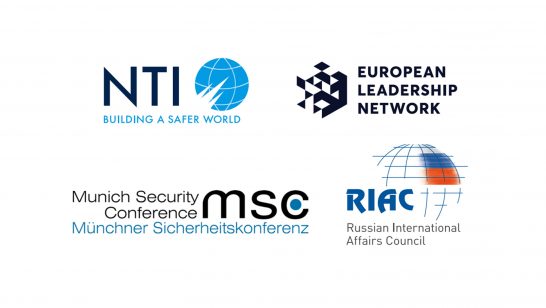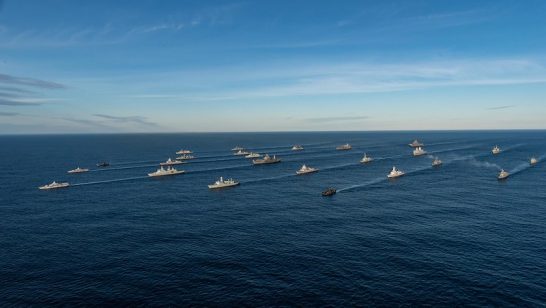Today, there is a growing risk of—and a potentially catastrophic inattention to—a security crisis involving an escalation or miscalculation leading to nuclear use. Beginning next weekend at the G7 summit and proceeding through next week’s NATO, US-EU, and US-Russia summit meetings, leaders will have a rare opportunity to advance multilateral dialogue, principles and practical steps to improve mutual security at a precarious moment.
In advance of these crucial meetings, the Euro-Atlantic Security Leadership Group (EASLG) is releasing a new statement, “Advancing Strategic Stability in the Euro-Atlantic Region, 2021 and Beyond.” The statement shows how security would be strengthened through restored dialogue, a set of principles to advance strategic stability and reduce the risk of miscalculation, and steps for managing instability and building mutual security. The statement is backed by an impressive group of former and current senior officials, military leaders, and experts from across the Euro-Atlantic region.
The statement sets out six principles to advance strategic stability and reduce the risk of miscalculation:
- Restore dialogue. We cannot have strategic stability without dialogue. The absence of dialogue erodes stability. The tools of communication are not being used as they should be. Dialogue and diplomacy have become a reward, not a tool. This lack of dialogue hinders our ability to understand the perspective of others, sharpens mistrust, and increases risks. Across the region, dialogue now between leaders remains essential to creating the political space for civilian and military officials to engage. The proposed meeting between the U.S. and Russian presidents in Europe offers the opportunity to begin an important new dialogue on strategic stability.
- Manage instability—and build mutual security. In the near-term, dialogue now at all levels should be focused on managing instability. We do not, however, want dialogue simply to reinforce the status quo; rather we need to define where we would like to be in, for example, 5–10 years—a vision centered on building mutual security—and identify the tools necessary to get there.
- Increasing leadership decision time. Creating robust and accepted methods to increase decision time for leaders, especially during heightened tensions and extreme situations when leaders fear they may be under threat of attack, could be a common conceptual goal that links both near- and long-term steps for managing instability and building mutual security.
- Manage and control emerging threats and technologies. The risks and challenges to Euro-Atlantic and global security today are broader than existential nuclear threats, and engage increased numbers of players including constellations of nation-states and the private sector. Underlined by the devastating impact of the COVID-19 pandemic, risks have changed and are higher in today’s world, including the challenges that come with emerging technologies, such as cyber and hypersonic capabilities, which can dangerously compress decision-time.
- Identify and advance areas of existential common interest. We have existential common interests where we can and must work together across the Euro-Atlantic space. These include preventing both the use of nuclear weapons and the erosion of arms control agreements that for decades have reduced nuclear risks.
- Increase transparency and predictability. Steps that increase transparency and predictability are essential to reduce near-term risks, and over the long-term, restore cooperation and trust.
The statement also provides eight steps for managing instability and building mutual security:
- Step 1: Reinforce the principle that a nuclear war cannot be won and must never be fought. This principle—articulated at the height of the Cold War by leaders of the United States and the Soviet Union and embraced by all European countries—was an important step in ending the Cold War. Today, it would clearly communicate that despite current tensions, leaders recognize their responsibility to work together to prevent nuclear catastrophe. Agreement on this key principle also could be a foundation for other practical steps to reduce the risk of nuclear use and avoid an arms race, and it would signal the commitment of nuclear powers to build on past progress toward disarmament—a vital demonstration of leadership
that would strengthen the Nuclear Non-Proliferation Treaty (NPT). Extending this step to include the five permanent members of the United Nations Security Council (the P5) would be an especially powerful statement in the NPT context. - Step 2: Deepen U.S.-Russia and West-Russia crisis management dialogue. Leaders should direct their respective governments to renew dialogue on crisis management—both bilaterally and multilaterally, for example via the NATO-Russia Council, or as a separate working group. In either case, the mandate should be focused on addressing concerns generated by day- to-day military events and activities, not political or strategic issues.
- Step 3: 1,400 in 2021. With New START extended for five years, Washington and Moscow should commit to further reduce U.S. and Russian deployed strategic nuclear weapons while working urgently to establish the mandate for and scope of a successor agreement to New START. As a first step, given that both nations have declared their deployed strategic warheads to be well under the New START limit of 1,550 for the past three years,1 a voluntary non-binding commitment not to exceed, for example, 1,400 deployed warheads by the end of 2021 should be feasible and would be symbolically important for the NPT Review Conference. This should be followed over the long-term by a successor nuclear reductions agreement before New START expires.
- Step 4: Conduct internal “fail-safe” reviews. All nuclear weapon states should commit to conduct internal reviews of their nuclear command and control systems, including “fail-safe” steps to strengthen safeguards against cyber threats and unauthorized, inadvertent, or accidental use of a nuclear weapon. These reviews should also include options for increasing warning and decision time for leaders, both unilaterally and in concert.
- Step 5: Open a new dialogue. Direct a new strategic dialogue among Euro-Atlantic states about building mutual security—in both new and existing tracks, such as the Russia-NATO Council and the Organization for Security and Co-operation in Europe. This new dialogue must be mandated by political leaders to address core security issues and divides within the region. It should identify risks and challenges associated with strategic stability today, including those arising from new types of nuclear and non-nuclear strategic weapons, emerging technologies, missile defense, cyber, and space.2 It should also focus on conflict areas and identify potentially destabilizing features of military strategies in the Euro-Atlantic region, including nuclear doctrines and practices that increase risks of accident, miscalculation or blunder leading to a military conflict. It should reduce misunderstanding to prevent future conflicts. The EASLG can provide a foundation for this work, which should involve the planning and strategy departments of foreign affairs and defense ministries from across the region.
- Step 6: Agree to ban INF-range missile deployment. Implement a ban on the deployment of Russian and U.S. land-based INF-range missile systems that would apply to the Euro-Atlantic region and, when possible, more broadly. Otherwise, leaders could once again become consumed with fears of a short-warning nuclear attack that could decapitate a nation’s command and control, which would greatly increase the risk of catastrophe in the event of false warnings. This will require an agreement on the systems to be banned and accompanying verification measures.
- Step 7: Establish cyber nuclear “rules of the road.” The risk of any one incident or set of circumstances leading to nuclear escalation is greatly exacerbated by new hybrid threats, such as cyber risks to early warning and command and control systems. Cyber threats can emerge at any point during a crisis and trigger misunderstandings and unintended signals—magnified by the difficulties in attribution and real-time attack assessment—that could precipitate war. Initiatives to establish rules of the road or red-lines precluding cyberattacks on nuclear facilities, nuclear command- and-control structures, or early warning systems would reduce fears of being blinded in the early stages of a crisis or conflict, and help maximize decision time.
- Step 8: Establish a Joint Data Exchange Center. The United States, Russia, and NATO should commit to updating the June 2000 U.S.-Russia agreement to establish a joint data exchange center for the exchange of data from early warning systems and notifications of missile launches to include all of NATO (or perhaps implement the center concept “virtually”). The new U.S.-NATO-Russia center could be expanded over time to include other nations facing missile threats, including China, making it a truly global center for nuclear threat reduction. A clear benefit of the center would be to bring together U.S.-NATO-Russia personnel in “day-to-day” operations on a dedicated joint activity. The center could also have potential for cooperation in other related areas, including cyber and space.
Read the full statement here.
The opinions articulated above represent the views of the signatories and do not necessarily reflect the position of the European Leadership Network or any of its members. The ELN’s aim is to encourage debates that will help develop Europe’s capacity to address the pressing foreign, defence, and security policy challenges of our time.
Image: Flickr, Todd Lappin



